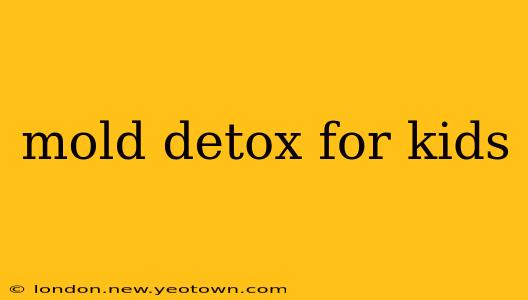Mold Detox for Kids: A Parent's Guide to Protecting Little Ones
Discovering mold in your home can be terrifying, especially when you have children. The thought of your little ones being exposed to potentially harmful mycotoxins is understandably alarming. This isn't about a quick fix; it's about a comprehensive approach to mitigating mold exposure and supporting your child's health. Let's navigate this together.
What are the common signs of mold exposure in children?
This is a crucial question, as early detection is key. Many symptoms overlap with common childhood illnesses, making diagnosis challenging. Keep a close eye out for persistent coughing, sneezing, runny nose, itchy eyes, skin rashes, headaches, and fatigue. If your child experiences these symptoms, particularly if they worsen when they're at home, it warrants a closer look. Remember, a doctor's diagnosis is vital for ruling out other conditions.
How can I detox my child from mold exposure?
There's no single "mold detox" for children. The focus should be on removing the mold source and supporting your child's body's natural detoxification processes. This is a multifaceted strategy.
First, and most importantly, professional mold remediation is essential. This isn't a DIY project. Mold often hides in hard-to-reach places, and improper removal can spread spores, worsening the problem. A certified professional will identify the source, remove the mold safely, and prevent future growth. Air quality testing before and after remediation is crucial to confirm its effectiveness.
Second, improve indoor air quality. Once the mold is gone, you need to maintain a clean, healthy environment. This includes regular cleaning, using air purifiers with HEPA filters, and ensuring proper ventilation. Consider using a dehumidifier to reduce moisture, as mold thrives in damp environments.
Third, support your child's immune system. A strong immune system is better equipped to handle mycotoxin exposure. This involves a healthy diet rich in fruits, vegetables, and whole grains, adequate sleep, and minimizing stress. Probiotics can also support gut health, which plays a significant role in overall immunity. Always consult your pediatrician before introducing any supplements or making significant dietary changes.
What are some natural ways to support my child's body after mold exposure?
Some parents explore natural approaches to support their children's well-being after mold exposure. These often focus on supporting the liver and kidneys, the body's primary detoxification organs. However, it's crucial to emphasize that these methods should be considered supportive measures, not replacements for professional mold remediation and medical advice.
Some commonly discussed options include:
- Hydration: Plenty of water helps flush toxins from the body.
- Nutritious diet: Focusing on foods rich in antioxidants and vitamins can support the body's natural detoxification processes.
- Specific foods and nutrients: Some parents explore foods like cilantro, chlorella, and activated charcoal, believed to have binding properties that may help eliminate toxins. However, the scientific evidence supporting these claims is limited, and it's crucial to consult a doctor before using them, especially for children.
Remember, this is not an exhaustive list, and the effectiveness of these methods varies.
Should I give my child medication after mold exposure?
Whether medication is necessary depends entirely on your child's symptoms and their severity. Some children may only experience mild symptoms that resolve on their own with supportive care. Others might require medication to manage symptoms like allergies or respiratory problems. A pediatrician's assessment is essential to determine the appropriate course of action. Never self-medicate your child.
What about testing for mold exposure in children?
Testing for mold exposure usually focuses on testing the environment (air and surface samples) rather than directly testing the child. While blood tests for mycotoxins exist, their interpretation can be complex, and they aren't always routinely used for mold exposure assessment. Your doctor can advise on the best course of action based on your child’s symptoms and the environmental assessment.
Disclaimer: This information is for educational purposes only and should not be considered medical advice. Always consult with a healthcare professional before making any decisions related to your child's health. The information provided here is intended to supplement, not replace, professional medical advice. Professional mold remediation is critical for addressing mold issues in the home.

